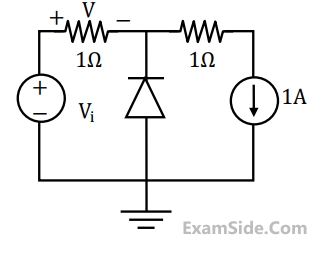1
GATE ECE 2013
MCQ (Single Correct Answer)
+2
-0.6
In the circuit shown below, the knee current of the ideal Zener diode is 10 mA. To
maintain 5V across RL, the minimum value of RL
in Ω and the minimum power
rating of the Zener diode in mW, respectively, are


2
GATE ECE 2009
MCQ (Single Correct Answer)
+2
-0.6
In the circuit below, the diode is ideal. The voltage V is given by


3
GATE ECE 2007
MCQ (Single Correct Answer)
+2
-0.6
A P+-N junction has a built-in potential of 0.8 V. The depletion layer width at a
reverse bias of 1.2V is 2 µm. For a reverse bias of 7.2 V, the depletion layer
width will be:
4
GATE ECE 2005
MCQ (Single Correct Answer)
+2
-0.6
The Zener diode in the regulator circuit shown in figure has a Zener voltage of
5.8 Volts and a Zener knee current of 0.5 mA. The maximum load current drawn
from this circuit ensuring proper functioning over the input voltage range
between 20 and 30 Volts, is


Questions Asked from Marks 2
GATE ECE 2025 (1) GATE ECE 2024 (1) GATE ECE 2022 (1) GATE ECE 2017 Set 2 (1) GATE ECE 2016 Set 3 (1) GATE ECE 2016 Set 2 (1) GATE ECE 2015 Set 3 (1) GATE ECE 2015 Set 1 (1) GATE ECE 2014 Set 2 (1) GATE ECE 2013 (1) GATE ECE 2009 (1) GATE ECE 2007 (1) GATE ECE 2005 (2) GATE ECE 2003 (2) GATE ECE 1993 (1) GATE ECE 1992 (1) GATE ECE 1991 (2) GATE ECE 1987 (1)
GATE ECE Subjects
Signals and Systems
Network Theory
Control Systems
Digital Circuits
General Aptitude
Electronic Devices and VLSI
Analog Circuits
Engineering Mathematics
Microprocessors
Communications
Electromagnetics